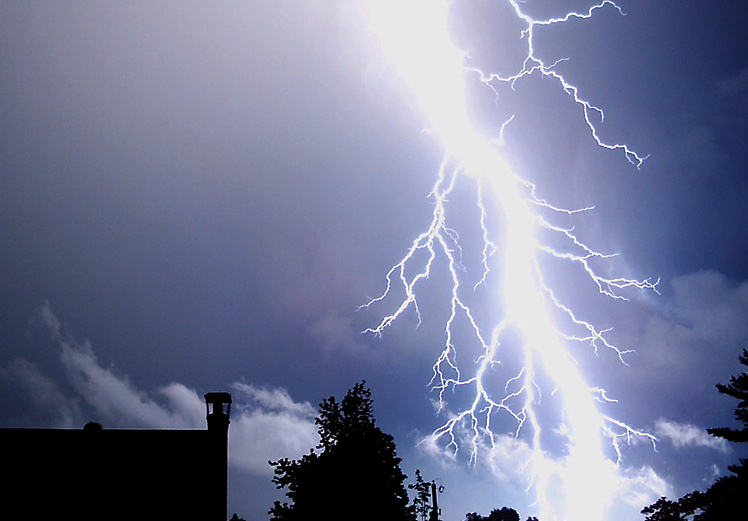
Credit: Mark Coldren (public domain), via Wikimedia Commons
Lightning is famous for starting forest fires, making thunder that scares the family dog, and, rarely, striking a golfer who’s stuck out in a storm.
Not exactly a good reputation—so it might surprise you to know that lightning is essential to life on Earth.
Lightning forms when freezing water droplets fall through a cloud, carrying a small charge with them. Millions of falling drops eventually build up a negative charge at the bottom of the cloud.
When the charge becomes powerful enough, it slices through the air in a bolt of current, connecting to a positively charged area to neutralize it. This could be the ground below or, more often, the top of the cloud.
The bolt is just 1 inch wide and lasts one-fifth of a second. It travels at 200,000 miles per hour and heats the air around it hotter than the surface of the sun. This air expands very rapidly, and the shock wave is heard as thunder.
As lightning blasts through the atmosphere, it breaks apart nitrogen molecules. This allows them to combine with oxygen in the air to form nitrogen oxides. The rain dissolves these into nitrates, then carries them to Earth and into the soil.
Nitrates are the most easily absorbed form of nitrogen for plants, which require nitrogen to thrive.
And thriving plants are the base of the food web that all other creatures depend on.
Just another reminder that everything is interlinked on our amazing planet—and these connections can sometimes be shocking.
Background
Synopsis: From Zeus to Thor to Buddha, lightning was thought to be a supernatural weapon of the gods, leaving humans awestruck to this day. How does lightning work?
- Lightning, one of the oldest observed natural phenomena on Earth, is also one of the least understood.
- Lightning is normally produced by thunderstorms, but it can also occur during volcanic eruptions, extremely intense forest fires, surface nuclear detonations, and heavy snowstorms—all of which may create their own weather.
- Lightning is a sudden electrostatic discharge caused by positive and negative charge imbalances between storm clouds and the ground, or within the clouds themselves.
- Updrafts and downdrafts in close proximity in thunderclouds cause partitioning of positive and negative charges as electrons shear off and collect on descending semi-frozen water particles, creating a negative charge at the base of the cloud and a positive charge at its top.
- Freezing particles are essential to the development of lightning.
- Objects on the ground below the negatively charged bases of thunderclouds become positively charged.
- Normally, air insulates the differing charges, but when they build up enough, the lightning strikes as a current passes between the charges to remedy the imbalance.
- More than 2,000 thunderstorms happen simultaneously every day around the globe—that makes more than 14.5 million storms per year!
- NASA satellites indicate that these storms produce at least 40 lightning strikes per second around the globe, which translates to more than 1.4 billion lightning strikes per year on our electrified planet.
- Lightning is most common in equatorial regions and more frequent over land; land surface gets more heated during the day, causing more-intense atmospheric convection, which in turn leads to lightning.
- The most lightning on Earth occurs in the mountainous eastern Democratic Republic of the Congo near the small village of Kifuka just south of the equator.
- Humid air that has traveled over 1,000 miles from the Atlantic lifts along the mountain front near Kifuka to create incredibly violent storms.
- The area averages more than 400 lightning strikes per square mile in a year.
- Cumulonimbus clouds, which have bases less than 1 mile high and tops nearly 10 miles high, typically produce lightning.
- Only about 25% of lightning strikes go from the clouds to the ground; the rest occur within the clouds and are called lightning flashes.
- Lightning only lasts 0.2 seconds and is a combination of many much shorter flashes (strokes) of around 30 microseconds.
- Lightning bolts are only an inch wide and travel at more than 200,000 mph.
- Lightning causes light in the form of plasma and sound in the form of thunder.
- The air along the path of the lightning is heated to more than18,000 degrees Fahrenheit, much hotter than the sun’s surface. This heating causes the air to rapidly expand, creating a shock wave known as thunder.
- Lightning can be seen from 100 miles away, but thunder can only be heard about 15 miles away.
- Did you ever notice how plants perk up after a thunderstorm? Lightning improves the chemistry of rainwater for plants.
- Rainwater has been distilled into pure water during evaporation from Earth’s surface.
- Lightning breaks apart nitrogen molecules (N2) so they can combine with oxygen to form nitrogen oxides, which dissolve in rain to form nitrates, slightly acidifying the rainwater.
- Nitrates are the most biologically available form of nitrogen and—along with phosphorous and potassium—one of three key macronutrients needed for plants to thrive.
- Lightning is an essential part of the nitrogen cycle on Earth.

